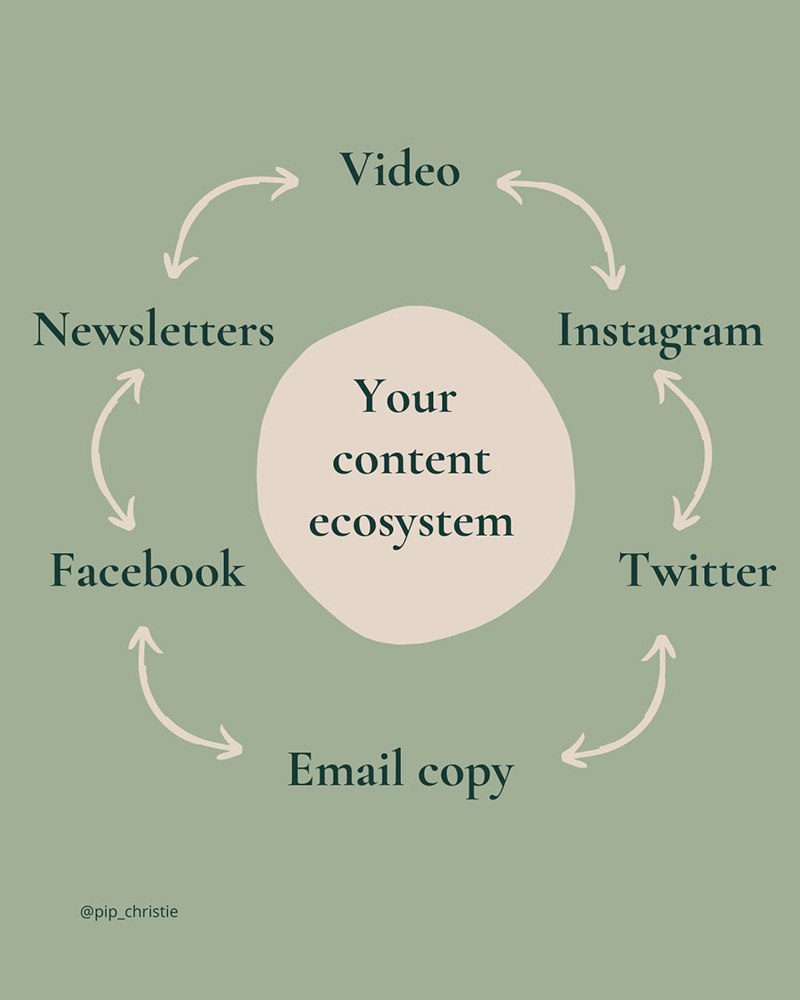So you’re a small business. It’s a pretty awesome place to be. You’re running things on your own terms, pursuing a passion and joining a community of fellow small business owners doing what they love.
But oosh. It can be tricky sometimes, can’t it? Time is limited and your budget even more so. Making finding inexpensive marketing ideas for your small business a must.

Inexpensive marketing ideas: the basics
These are the foundational things you need to get started. Without these… well, your small business is going to be finding life a little bit tricky.
So set these up first. And then build your business from there.
1. Research your audience
You won’t find a list of marketing ideas out there without this one on it. And there’s a good reason for that. Because if you don’t know your audience, you’re going to be wasting your time on marketing activities that are ineffective and plain old disappointing.
So let’s skip all that. And speak to your dream audience instead. Ask them what they want, what they’d love to achieve and how they’d love to feel. You can use this list of questions to get you started.
Copywriter’s tip: don’t have an audience to interview yet? Find some folks who would be in your niche and ask if you can chat to them in exchange for a free consultation or product.
2. Write website copy that speaks to your ideal customer’s desires
Now that you know your audience, it’s time to put those lessons into practice.
Take a look at the words they used to describe your work and business, and use those on your website. So you can create engaging brand messaging and website copy that builds connections, right from the very first word.
3. Create your website (and brand visuals)
Every small business needs a website. And no, an Etsy profile doesn’t count.
This is about creating a space that is your own. Where you can do things your way and welcome your potential customers into your online home.
4. Set up your social media profiles
Repeat after me: “I do not need to be in all the places”. Instead, look at where your ideal customers hang out and position yourself there instead.
Maybe they’re on TikTok but not Facebook. So focus your attention on short-form videos and skip the lengthy Facebook posts.
5. Prep your email list
Yes, this is a business basic. Before you move on, make sure you have a way of collecting email addresses and sending out a newsletter. It’s essential (and inexpensive).

Inexpensive marketing ideas: the next level
Now that you’ve got the foundations sorted, it’s time to move up a level. These inexpensive marketing ideas are designed to be dipped in and out of when the need arises.
Most can be done in under an hour and for less than £50.
6. Write a blog post for SEO
Social media wants to tell you that blogging is “dead”. It isn’t. It’s just changed.
Gone are the days of long personal diary-style posts. Instead, blog posts should be focused on creating a clear value for your reader, using SEO keywords to make them searchable.
Copywriter’s tip: take a look at Keywords Everywhere for an easy and inexpensive way to find the right keywords for your website.
7. Pitch your brand to another website to get backlinks
Make a list of websites that are in your niche. These shouldn’t be competitors. Rather, look at complementary websites and businesses that could help you grow.
If they have a blog, put together a pitch and see if you can get featured by them. This could be with a guest article or interview piece. Then, ask for a link back to your own website. This will help you see more authoritative in the eyes of Google, helping you to rank more highly in search results.
8. Run a giveaway
This is a great way to expand your audience. Put together a giveaway around one of your most popular products, asking people to either follow you on social media or join your email list to enter.
Then, offer a timely discount to those who didn’t win to help generate more sales.
9. Write a sales email to your list
When was the last time you emailed your list about a product or service?
Create a short but sweet email updating your audience on a new offer, a product that’s back in stock or a solution that’s perfect for this time of year.
10. Set up a welcome sequence
Take a look at what happens after subscribers join your email list. This is your chance to build trust, create a connection and nurture them towards a sale.
Write copy for two or three emails to help get them there. Then, add it to your email scheduler and celebrate with a cup of tea.
11. Add a referral perk to your newsletter
If people are already reading your newsletters and loving what you create, then they’re going to be one of your best ways of getting more readers. After all, word-of-mouth marketing is one of the most effective ways to grow your small business.
Try adding a referral programme to your newsletter and see what your subscribers can do for you.
12. Create an affiliate programme for your small business
Most of us love telling our friends about products we’ve found and loved. And we love it even more when we get a little kickback for it.
Take a look at how you can create an affiliate programme for your product-based business, making it that much easier to grow your sales through your pre-existing audience.
13. Establish a client referral programme for your service-based business
One of the best ways to grow a service-based business is through word of mouth. And just like a product-based business, your clients deserve to be rewarded for that.
Consider adding a bonus discount, free consultation or special gift to give a little extra incentive to those all-important referrals.
14. Create an email to past customers asking for a review
Word of mouth is the oldest form of marketing there is. And asking for reviews is the modern-day equivalent.
When prospective customers see testimonials from people just like them, talking about achieving the outcome they’re craving, they’re far more likely to buy. So make it easy for them. And set up an email for your past clients and customers to ask for that all-important review (you’ll be surprised how lovely the responses are, promise).
15. Set up a Google My Business account
Your Google My Business account is a super duper handy too. For starters, it can give your local SEO a juicy boost, as you pop up in local search results. But it also helps to strengthen trust in your business, as customers add organic reviews, share photos and videos, and engage with your profile.
Plus, if you’re a brick-and-mortar business, it’s a must. It’s how your visitors find you! Here’s how to get started.
16. Batch your Pinterest pins
Pinterest is essentially a visual search engine. Making it the perfect tool for customers to discover your blog posts, get inspired by your products and, ultimately, drive traffic to your website. Yep, more traffic than most other social platforms.
So pop a podcast on and batch a load of pins. Not sure how to get started? Try Canva for some free and easy templates.
17. Pitch to journalists for an interview
Each of these inexpensive ways to market your small business is about getting more eyes on your work. And not just any eyes, the right eyes.
Think about your ideal customers. What publications do they read? What magazines do they have stacked up on their coffee table? Reach out to the editors and journalists behind those publications. Try pitching for a feature, proposing an interview or, even better, putting a piece of your own writing forward as a contributor.
18. List your business in a relevant directory
Directories can be great (think Yellow Pages, but within your niche and digitalised!). You’ve just got to find the right one.
Get yourself onto Google, ask your fellow business owner friends, and find a few directories within your niche. Then, add your profile. Not only is this great for getting your name out there but you’ll be getting a backlink or two to your website too. And your SEO will like that.
19. Collaborate with a fellow small business
Know someone with a similar ideal audience to you? Do your products or services complement one another?
Try a collaboration. It could be as simple as hosting a co-live on Instagram, writing a piece for each other’s blogs or taking over each other’s social media accounts for the day. Or, get creative and come up with a product collaboration together.

20. Host a free workshop around your work
Slow marketing is all about adding value to your audience. And a free workshop can be a great way to do that.
You get to introduce your work to potential customers (and help them see how it can fit into their lives). And your customers get to sample your offerings, build a deeper connection with you and learn something new.
Try not to overcomplicate it. Look through past questions for topic ideas and go from there.
21. Schedule your social media posts in advance
Yes, this one is simple. But we all forget to do it.
Batching your content in advance won’t just save you time, it’ll help you be more consistent too.
22. Spend 30 minutes engaging with your ideal audience on Instagram
Instagram’s a social media platform. Which means it’s a great place to chat with people.
Get into the comments section of your posts, comment on posts from other folks your audience will follow and pop over to those tagged photos to say hello. It’s all about strengthening that connection.
23. Book an advertising spot in a small publication your audience consumes
Many advertising spaces aren’t as expensive as you might think they are. So take a look through those dreamy publications and find out what a spot will cost.
Bonus tip: if you do go ahead, try and find a way to track the impact. For example, add a unique discount code to your advert to help you track how many sales you made.
24. Create a lead magnet your audience will genuinely find useful
The best lead magnets are the ones that have people asking, “wait, this is seriously free?”. Those are the ones that’ll keep people on your email list, keep your work front of mind and keep them recommending you to their friends.
25. Conduct a mini-audit of your website
How clear is the visitor journey through your website? Is it obvious where to go next? Or are folks getting lost somewhere between your homepage and your store?
Put yourself in the shoes of someone who’s never been on your website before (or ask a friend to test it out for you). And then make those little tweaks to help the journey feel a little more seamless.
26. Upgrade your product descriptions
Take a second to look through your product or service descriptions.
Are you showcasing:
- The outcome of your offer i.e. how people will feel as a result?
- The need to know i.e. practical details?
- The keywords your audience will use to find your product i.e. what folks are typing into Google?
- The objection reassurance i.e. the worries potential customers might have and how you’re helping them overcome those concerns?
If not, it’s time to give those descriptions an upgrade and add those messages in!
27. Plan a timely marketing campaign
Christmas. Valentine’s Day. Easter. Summer. Back to school. There are so many moments throughout the year when shining a brighter light on your work can help you generate some extra sales.
So, get ahead. Set aside some time to plan your next marketing campaign a few months before it’ll need to kickoff. And then pour yourself a cuppa and feel smug, because you’re oh-so-organised.
28. Gather your user-generated content and share it
Whenever a customer or client creates a piece of content about your work, they’re giving you a very handy marketing tool.
Again, they’re helping people to trust your business. Because they’re showing how your work supported them.
You can use that. Add it to your Instagram Stories, round it up in a blog post, feature it on your product pages. Just remember to ask for permission and always give them the relevant credits.
29. Pitch gifted products to influencers in your niche
The best way to get your products featured by an influencer you love, is to pitch it first. You’ll find a super handy guide on exactly that from Studio Cotton over here.
My top tip? Batch your pitches together. Try to tie them in with a timely product push (like that marketing campaign you planned earlier) rather than going at them ad hoc. People need to see your brand multiple times before they’ll make a purchase so having your work featured by lots of different influences will help that.
30. Simplify your marketing plan
The biggest piece of advice I can give any small business about their marketing is to keep it simple. Plan to do less than you think is possible, because it’ll always take more time!
31. Check your site load speed
How long does your website take to load? If it’s too slow, people are going to click that “X” button and head off elsewhere.
One of the biggest culprits is large photos. So be sure to re-size your images to around 20MB before uploading them to your site (and where possible, use a jpg file not a png, they’re much smaller).
This free tool can help you check your speed.
32. Review your website on mobile
Once again, you don’t want to be losing customers. You’ve put in all that hard work to get them to your website, we don’t want them leaving just because your website doesn’t load properly on mobile.
Have a look through your website from a phone (or, if you’re techy, you can preview it on your desktop using Google’s inspect tool) and see if you need to make any changes.
33. Reward your regular customers with a loyalty scheme
Once someone’s already become a customer, they’re far more likely to buy from you again. And you can make it even easier for them.
Say thank you with special offers, send a Christmas gift their way or give back with a surprise each year. The aim here is to ensure they feel good and feel valued. So feel free to get creative!
34. Reorganise the shop section of your website
We all need to do a bit of spring cleaning now and again. And when you run an online store, that need can become even greater.
If you’re feeling intimidated about your online store right now, try this. Put yourself into the shoes of your customer. What are they looking for? How would they like to browse your digital shopfront?
Try to give them clear categories to click through, so they can always find what they’re looking for without any hassle.
35. Repurpose your past content
A social media post might have a short shelf life but that doesn’t mean you can’t recycle it. Turn old content into new posts (and make your content creation process a lot faster whilst you’re at it).
One blog post can become a YouTube video (great for your SEO), around three Instagram posts, a few Instagram story series, ten Pinterest pins, one newsletter and so on. There’s a lot of life in that content of yours!

36. Create a set of content buckets
Your content creation becomes a lot less complex when you’re focused on a few key areas. That’s where content buckets come in.
Instead of talking about everything that’s remotely linked to your work, you niche your content down into 3-4 set areas. These are your content buckets.
By focusing your content in this way, you’re able to dive deeper into topics whilst building your expertise (and your brand reputation) in a few key areas.
37. Update the hero section of your homepage
This one’s essential for product-based businesses and I recommend doing it at least once each season.
Your hero section (the top section of your homepage, that people see first before scrolling down) is your place to promote your most recent product launches, seasonal collections or current offers. Use it wisely!
38. Take a rest
Sometimes, the best thing you can do for your business is to leave it alone for a little while.
Take a break, rest and recharge. Then, come back with new energy and more creative ideas. This is what’s going to keep you consistent, by giving your mind (and body) what it needs.
Phewph. There you have it. A whole host of inexpensive marketing ideas for your small business. Which one will you try first?

